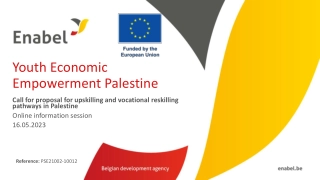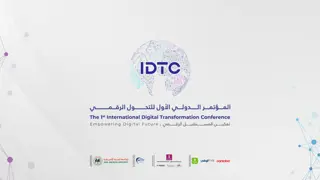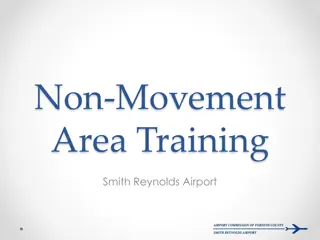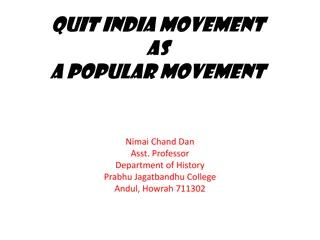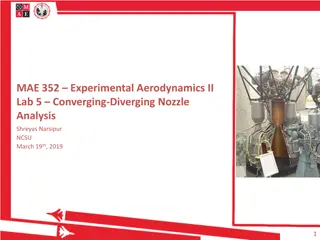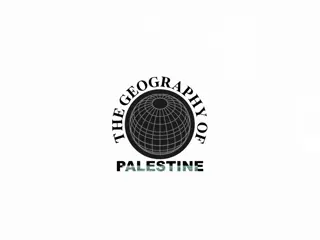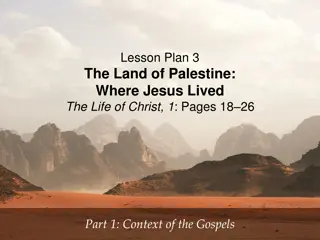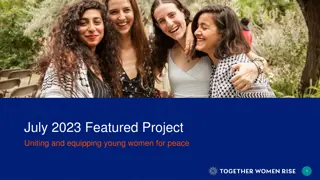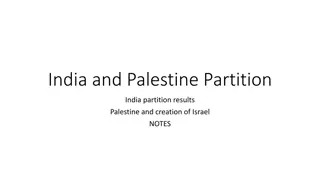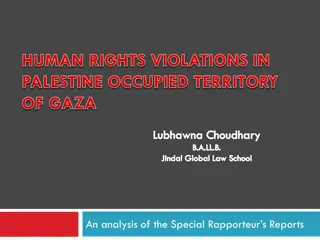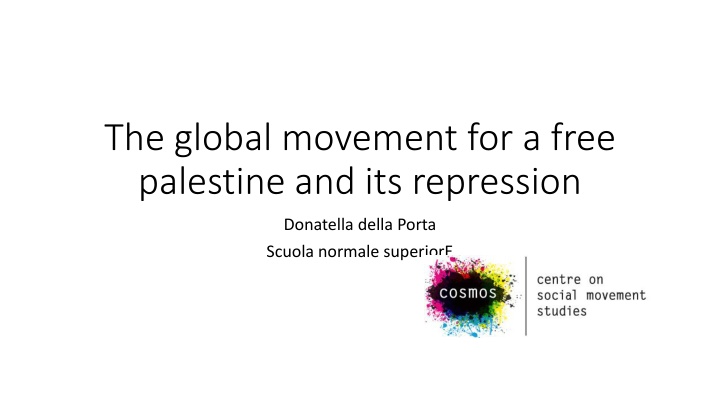
The Global Movement for a Free Palestine: Converging Struggles and Repressive Strategies
A discussion on the global movement for a free Palestine, its converging struggles, organizational convergences, complex repertoire, repressive strategies, and societal reactions influenced by folk devils and moral panics.
Uploaded on | 4 Views
Download Presentation

Please find below an Image/Link to download the presentation.
The content on the website is provided AS IS for your information and personal use only. It may not be sold, licensed, or shared on other websites without obtaining consent from the author. If you encounter any issues during the download, it is possible that the publisher has removed the file from their server.
You are allowed to download the files provided on this website for personal or commercial use, subject to the condition that they are used lawfully. All files are the property of their respective owners.
The content on the website is provided AS IS for your information and personal use only. It may not be sold, licensed, or shared on other websites without obtaining consent from the author.
E N D
Presentation Transcript
The global movement for a free palestine and its repression Donatella della Porta Scuola normale superiorE
The global movement for a free Palestine: converging struggles, bridging frames A movement of international solidarity A movement against the war (in a time of militarization) movement against colonialist legacies A movement against capitalism, racism and patriarchy A A movement against the Far Right and the right-wing turn of mainstream party A movement against an authoritarian turn A movement on the educational system A movement on labour
Organizational convergences convergences Loose networks of cooperation between SMOs, CSOs, Unions, ethnic communities through: Alliances in the streets Expert based campaigns Prefigurative spaces
A complex repertoire repertoire: legacies and innovation The logic of number in the street demonstrations The logic of damage in the boycott The logic of testimony in the camps
Repressive strategy Repressive strategy Protest incapacitation Organizational outlawing Defamation Defunding
Folk Devils and Moral Panics, Cohen (1973) Societies appear to be subject, every now and then, to periods of moral panic. A condition, episode, person or group of persons emerges to become defined as a threat to societal values and interests; its nature is presented in a stylized and stereotypical fashion by the mass media; the moral barricades are manned by editors, bishops, politicians and other right-thinking people; socially accredited experts pronounce their diagnoses and solutions; ways of coping are evolved or (more often) resorted to
Policing the Crisis: Mugging, the State and Law and Order, Stuart Hall et al(1978) for the urban white middle classes, mugging encompassed a series of fears caused by the changing class and ethnic composition of the cities and a shift in the whole flavour and ambience of urban living. These changes precipitated not only a sense of panic but also the steady movement of whites out of the city . . . and the adoption of a whole series of protective and defensive moves. Playing on an underlying racist fear activated by feeling of threat among the white people who fled to the suburbs
Analytic categories The moral panic entrepreneurs: including journalists, politicians of various parties, the specialised administration bodies on anti- semitism, cultural and academic institutions, pressure groups such as official representatives of the Jewish community, and representatives of the state of Israel; The folk devils: foreign progressive intellectuals who had been critical of Israeli policies but also of racism, while not expressing any attack against the Jews, in some cases being Jews themselves; The disciplining: with witch hunt campaigns ending up in the withdrawal of prizes, conferring cerimonies, appointments and contracts.
bureaucratization of the policies against bureaucratization of the policies against antisemitism. antisemitism. a) the adoption of a highly contested definition of antisemitism which includes criticism of Israel, b) the definition of the non violent boycott of Israeli products by the BDS as antisemitism; c) the creation of a bureaucratic body devoted to the fight of antisemitism as separate from other already existing one that targeted antisemitism together with racism and discrimination in general.
The IHRA definition as main instrument of repression the IHRA legally non-binding working definition of anti-Semitism which stated that Antisemitism is a certain perception of Jews, which may be expressed as hatred toward Jews. Rhetorical and physical manifestations of antisemitism are directed toward Jewish or non-Jewish individuals and/or their property, toward Jewish community institutions and religious facilities . in a departure from the prevailing scholarly and legal definition that defined anti- Semitism in relation to the Jewish people, the document introduced references towards Israel, in stating that: Manifestations might include the targeting of the state of Israel, conceived as a Jewish collectivity. However, criticism of Israel similar to that leveled against any other country cannot be regarded as anti- Semitic . examples, included Denying the Jewish people their right to self-determination, e.g., by claiming that the existence of a State of Israel is a racist endeavor ; Drawing comparisons of contemporary Israeli policy to that of the Nazis ; or Holding Jews collectively responsible for actions of the state of Israel .
The political and cultural opportunities for the The political and cultural opportunities for the moral panic entrepreneurs moral panic entrepreneurs The bureaucratized apparatus for the struggle against a blurred definition of antisemitism results from political choices which include: a) political opportunities in the convergence of the party system on the defence of Israeli security as a raison d t at; and b) cultural opportunities in the separation of antisemitism from racism and the adoption of a clash-of-civilization narrative by mainstream parties with the declaration of the security of Israel as historical responsibility for Germany given the Holocaust but also a denial of responsibility for the Nakba as well as for colonialist crimes against humanity.
Exclusive memory as a racist tool the construction of an official memory of the Holocaust was generally presented as a success in the attempt to come to terms with a stigmatized identity (Moses 2007) and a search for normalization (Olick 2003), Germans prided themselves on having learnt from history, but it was becoming less clear what that lesson was (Trentmann 2023.).
Memory distortion Many and different victims of Nazism--6 million Jews, as well as 8 million non-Jewish Russians, Poles and Serbians, 3 million prisoners of war, 500,000 Roma and Sinti, about 250,000 people with disabilities, and hundreds of thousands of political opponents, gay people, or religious minorities Many forms of genocide: It makes perfect sense that the Holocaust is remembered as the ultimate evil among European thinkers, because it was easily the worst crime that happened in living memory in Europe. It makes just as much sense that it is not remembered thus in all the rest of the world, which instead experienced the mass deaths and forced labour of colonialism (Sznaider 2021).
it was in the 2000s that a more simplistic narrative of a nation of sinners turned into saints began to emerge, with the presentation of Germany as a moral leader in dealing with its dark past (Trenntman 2023.). Genocide and colonisation have always been legitimised by modernity, the superiority of the colonisers over the colonised. From this point of view, what is special about the Holocaust is only that the genocide has returned to Europe; the singularisation of the Holocaust then entails prioritising European experiences over non-European ones. Defenders of Israel complain that of all countries the only modern and democratic state in the Arab world is being criticised. De-colonial critics see such arguments in the name of modernity and Israel s alleged superiority over its neighbours as elements of the very same coloniality that was invoked for the colonisation of America and Africa (Michaels 2020).
An impossible order the assessment of the special responsibility of the Germans for the Holocaust with a resulting specifically German view, a German narrative, a German identity and a German responsibility tends to ignore the particular origin of this view and turns it into a universalism. The critique then imposes this universalism on everybody, including those who do not share in the particular German experience and responsibility. But since this universalism derives from German responsibility, Germans remain in control of the debate. German participants in the discussion demand of others not only that they acknowledge the achievement of a specifically German culture of remembrance , but also that they make it the foundation of their own thinking and speaking. Since we Germans are responsible for the Holocaust, we take the moral right to dictate to others what they have to say about it (Michaels 2020).
The anti-migrant focus As observed by Trentmann (2023, XXIX), Citizenship was opened up in 2000, but national identity far less so in part because the collective memory of Nazi crimes meant it was ethnic Germans who were remembering the sins of their fathers . Migrants are then put in the double bind as people identified as racialized immigrants that at the same time are told that in order to be German they have to remember the Holocaust, but also that they can never correctly remember the Holocaust as it is not part of their history (Rothberg and Yildiz 2011). If
As Younes (2020, 258) has noted, On the one hand, through the acknowledgment of the Holocaust, Germany self-identifies as having overcome the troubles of race; on the other hand, although there has been a considerable increase in (white-on-brown/black) racism, especially right after reunification in 1991, it is today non-white Germans or the newly arrived refugees that, according to public discourse and not according to statistical facts, are the biggest danger for the resurgence of racism (anti-Semitism)
The selection of the right Jews Susan Neiman (2023b) has remarked that it is not by chance that The most astonishing feature of this philosemitic fury is the way it has been used to attack Jews in Germany, including some descendants of Holocaust survivors . In the name of atoning for the crimes of their parents and grandparents, non-Jewish Germans publicly accuse Jewish writers, artists, and activists of antisemitism. This makes tenuous sense given that the main thing decades of historical reckoning have taught the Germans about Jews is: they were our victims
Societal actors and media as moral panic Societal actors and media as moral panic entrepreneurs entrepreneurs A third set of facilitating contextual conditions for the moral panic refers to civil society and mass media cultures and structures including: a) non-governmental organizations which are dependent upon public funds, selectively distributed, and therefore tendentially depoliticized and tamed; b) a media culture characterized by a tendency to rally around the mainstream country interests/values, in a media system characterized by labour precarity and firm concentration.
Concluding Moral panic as a mechanism of repression Clash of civilization as a self-fulfilling prophecy In a militarized time

